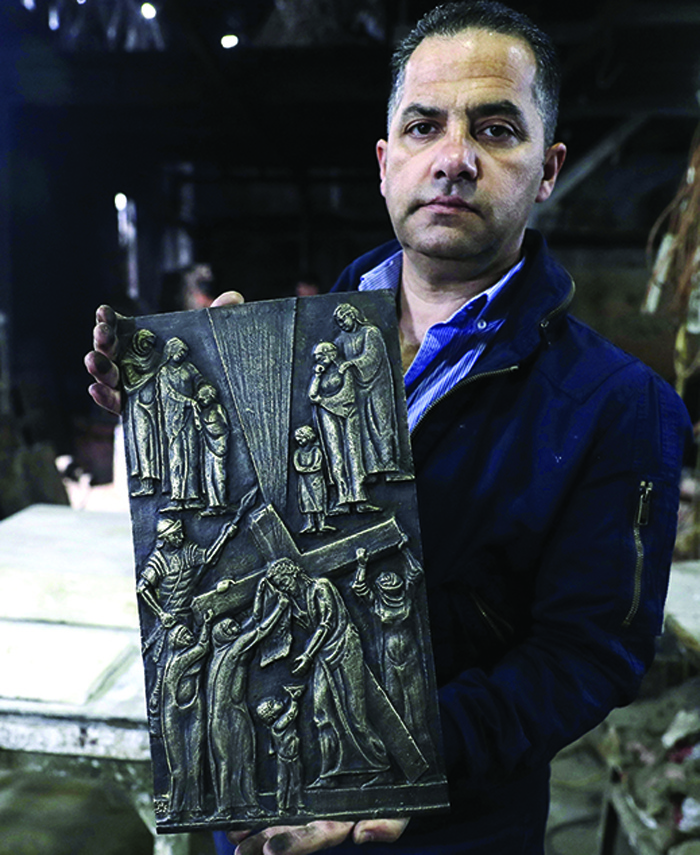Capping his first day in Iraq, Pope Francis was gifted a miniature of an extraordinary work of art depicting a stage on the path to Christ's crucifixion, designed by a Muslim artist. It was a touching welcome gift from President Barham Saleh, who invited Pope Francis to visit Iraq in 2019 -- hoping it could help the country "heal" after years of strife. The bronze plaque received by Francis is a potent symbol of the struggles of Iraq's ancient Christian community, as well as the country's exceptional interfaith links.
It is a small replica of the sixth "Station of the Cross", where a woman named Veronica wipes Jesus's brow as he makes the torturous 14-stage journey up the hill to be crucified. Fourteen stone plaques of the journey were designed by Mohammad Ghani Hikmat, one of Iraq's most celebrated sculptors who passed away in 2011. Work on the replica crafted in the Lebanese capital Beirut was personally overseen by his son Yasser, who kept its existence a secret until it was presented to Francis. "It's very symbolic of Iraq, because my father was an Arab Muslim sculptor who recounted through his works the passion of Christ," Hikmat told AFP. "It represents all of Iraq in that there's no difference between any of the sects," he said.
Four of the 14 pieces of "The Way of Suffering", sculpted plaques representing the stations of the cross by late Iraqi artist Mohammed Ghani Hikmat, are displayed at the Chaldean Catholic Church of the Ascension in the Mashtal district of the capital Baghdad .'Unlike any other'
The original stone works-imposing at two meters (yards) tall by a meter wide-indeed tell the story of Iraq. In 1993, as Iraqis faced crippling global sanctions targeting then-dictator Saddam Hussein, an elegant church was being painstakingly built on the outskirts of Baghdad. The original Chaldean Church of the Ascension had been expropriated by the state under Saddam, so the parish decided to build another branch in an agricultural district known as "Mashtal." The 5,600 Catholic families living in the area pooled together donations for several years to build the church, designed with traditional Iraqi mud bricks.
For the Stations of the Cross, the parish chose Mohammed Ghani Hikmat, who had designed most of the major statues at the heart of the capital's many roundabouts. He was already lauded at the time as the "sheikh of Iraqi sculptors," and having a top Muslim artist design such a central piece for a church was exceptional. "It's unlike those in any other Chaldean Church in the rest of the world," said Fadi Nadheer, the young bespectacled priest who has headed the Church of the Ascension since he was ordained in 2017. To make them, Hikmat locked himself away in his studio and entered what he would later describe as a "mystic trance".
'We must stand by Iraq'
Hikmat sourced the stone from the northern plains of Nineveh province, the heartland of Iraq's minorities and where some Christian villages still speak a modern dialect of the language used by Jesus two millennia ago. Little did he know that nearly three decades later, the head of the world's Catholics would travel to those very villages to encourage their dwindling residents. But the sculptor did carve little symbols of Iraq into the corners of each stele: a woman and child, representing the people suffering under the international embargo at the time.
The exceptional pieces are rarely seen. The church's imposing architecture and brightly-lit crosses along its external walls are hidden behind concrete blast walls, installed in 2007 during sectarian infighting in Iraq. Of the thousands of worshippers who attended the church three decades ago, just 400 families remain, most of whom dream of exile. But after living in the shadows for so long, Nadheer is thrilled that the work of Iraq's artists-and the plight of its Christians-would finally be brought to light.
"I didn't know how to express my joy... that copies of the works present in our church would be given to his Holiness the Pope as a gift from the Iraqi state," he told AFP. "Pope Francis is telling the word: 'This country that is called Iraq, we must take care of it. We must stand in solidarity with it. We must turn our attention and our thoughts towards it.'" - AFP




